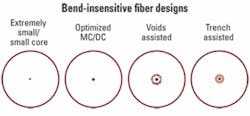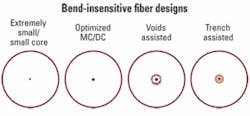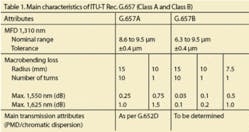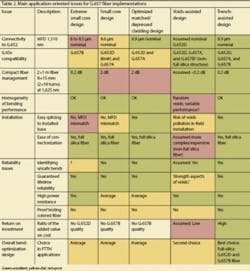by Olaf Storaasli and Laurent Gasca
As a result of the growing interest in FTTH architectures by more service providers, new bend-insensitive fibers are enjoying increased notoriety. Many new products have entered the market under a variety of names and performance levels. With these new fibers being intensely marketed and the market becoming more competitive, it's incumbent upon network architects to separate reality from all the hype.
This article will define the current bend-insensitive fiber products currently on the market and compare the different fiber classes. It will also try to answer many of the questions surrounding the issues involved in selecting the correct fiber for each FTTH application.
First, what does "bend insensitive" actually mean? Industry views are varied, probably resulting from the huge number of papers, articles, and product marketing materials being generated to promote these types of fiber. While some tend to downgrade reputable products with a negative slant, others tout these fibers as virtually indestructible. The confusion over what is actual fact may become hard to overcome.
However, there is progress being made, particularly with the November 2006 release of the ITU-T G.657 standard for bend-insensitive fiber. This standard divides these new fibers into two very distinct categories of fiber performance: Class A and Class B.
Class A is referred to as "bend tolerant" fiber. These products provide roughly 10X better macrobending performance when compared to traditional singlemode fiber. They also boast full backward compatibility to traditional fiber, meaning the fiber is compliant with G.652D, commonly referred to as the low water peak singlemode fiber specification.
Class B fibers are the truly bend-insensitive class, providing about 100X better bending performance than traditional singlemode fiber and about 7X to 10X better performance than the Class A products. The backward compatibility has not been required since one of the implementations included in Class B is a fiber design that uses very low mode field diameter (MFD), about 6 to 8.5 µm. Still, some Class B products do comply 100% with G.652D. Table 1 shows the main characteristics of both fiber classes.
Currently, there are five primary types of bend-insensitive singlemode fibers available: extreme small core, small core, optimized matched/depressed cladding, trench-assisted, and voids-assisted (see figure).
A sixth design, hole-assisted fiber and holey fibers, is in the early stages of development. The ability of these fibers to perform as a viable design option is being carefully investigated. Some of the major drawbacks include high manufacturing costs, very difficult splicing/connectorization, and physical strength.
A comparison of the five primary types provides the pros and cons of today's industrially promoted fibers.
Extreme small core diameter: This design is based on a higher refractive index of the core that is compensated by a reduced core diameter. It produces very low MFDs, typically 6 to 8.5 µm, and only complies with the G.657B standard. Practical use with the standard G.652 installed base of singlemode fiber is difficult due to the high splice losses attributed to the large difference in MFD.
Small core diameter: This design improves the MFD for 1,310 nm to the limit of G.657A, or about 8.6 µm, with only moderately improved bending performance compared to G.652D. Although splice losses are no longer a problem, optical time domain reflectometer (OTDR) issues — exaggerated loss (losers) and negative loss (gainers) — remain a problem in single-direction testing when these fibers are combined with the installed G.652D base.
Optimized matched/depressed cladding: These designs exhibit near-normal MFD, enabling the advantage of matching with installed base G.652 fibers. The bending performance, however, is only moderately improved. Based on their specifications, these fibers cannot guarantee low losses at 1,625 nm when used in a compact fiber management system with a 15-mm storage radius. For example, storing 2x1 m on both sides of a fiber splice is equal to 2x10 turns at this radius with maximum loss, according to G.657A, of 2x1 dB — still much too high for systems operating (currently or in the future) up to 1,625 nm.
Trench-assisted: This is the only full-silica fiber design currently available that offers the unique combination of virtually normal MFD coupled with the tightest bending specification of G.657B Class B fibers. Along with the voids-assisted fiber, trench-assisted fibers offer the only implementation still compatible to G.652D while reducing the size of fiber management systems down to 15-mm radius without higher losses at 1,625 nm. For example, for 2x1 m of stored fiber, the maximum loss is 2x0.1 dB. This guarantees the capability of access networks to handle future developments of WDM-PONs and IP video.
Voids-assisted: This design was recently introduced as a second implementation option offering G.657B performance and compatibility with the G.652D installed base. A ring of voids surrounding the fiber's core creates an equivalent lower index of refraction, similar to the cladding acting as a trench in the trench-assisted design. An important aspect is its deviation from a full-silica fiber, which raises questions about splicing capability, connectorization, and physical strength. Since it was only recently introduced, many aspects of this design are still being evaluated and clear specifications are lacking. Commercial availability is also unclear — but the biggest concern may be its cost/benefits relationship when compared with the trench-assisted design.
Facing the issues
Table 2 provides an overview of application-oriented issues for all five fiber designs. Along with the issues laid out in the preceding section, it summarizes additional challenges facing service providers.
For example, bend-insensitive fibers must be capable of easily splicing into the installed fiber base for brownfield or upgrade implementations. As previously stated, extreme small core designs will present high splice loss issues due to the MFD mismatch. One-way OTDR testing will also present MFD mismatch issues in extreme small and small core designs, showing sensitivity for losers and gainers. Installation technicians will also be concerned with ease of connectorization, particularly for the new voids-assisted designs that will likely add cost and limit field mounting.
Reliability issues must also be weighed when choosing which bend-insensitive fiber will fit a particular implementation. All bend-insensitive fibers have safety limits. Even the trench-assisted fibers will exhibit bend losses greater than 0.2 dB when approaching maximum bend radii.
Furthermore, service providers should understand that reliability is a critical marketing point for bend-insensitive fibers — and some manufacturers grossly overstate and understate the reliability attributes when making "objective" comparisons on fiber lifetime based on standard test methods.
When used in a central office (CO) or headend environment, it's important to ensure the selected fiber design can withstand high power in FTTH GPON systems or FTTH RF video overlays. With the lowest bending sensitivity issues, G.657B fibers provide the optimal performance in these implementations.
A comparison between pros and cons of the five bend-insensitive fiber designs currently being marketed will generate many questions from service providers. Getting the right responses is important for informed decision-making about the appropriate fiber implementation for each unique deployment scenario.
Raising issues associated with bend requirements, high power performance, fiber management, compatibility, splicing/connectorization, futureproofing, temperature, testing, cost, and overall reliability is smart planning. Reviewing test data against current standards requirements will help ensure the right fiber design for the right application.
As bend-insensitive fibers continue to emerge in a competitive multivendor market, the overall result is continuous product improvement — resulting in cost and performance benefits for the service providers.
Olaf Storaasli is a product manager and Laurent Gasca is a product line manager at Draka Communications (www.draka.com), headquartered in Amsterdam, the Netherlands.



